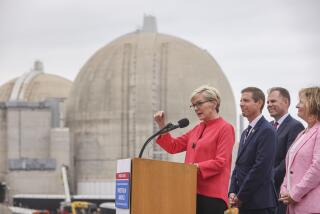TRW, Lockheed: High-Tech Help
- Share via
TRW Inc. and Lockheed Corp., which built some of the nation’s most capable spy satellites during the Cold War, are trying to apply that same technology to help clean up radioactive waste left from the nuclear arms race.
The work is part of a broad effort by the Energy Department to use advanced technology to cut the staggering cost of cleaning thousands of contaminated sites across the nation.
A Lockheed computer chip crucial to radar-imaging satellites may allow a breakthrough in increasing the rate at which contaminated soil can be processed, company officials say.
The Lockheed work is under way at the Idaho National Engineering Laboratory, a huge nuclear weapons facility where the Energy Department buried 6 million cubic feet of plutonium from the 1950s until the 1980s.
The plutonium and other radioactive elements were packaged in steel barrels and placed in shallow pits, where the drums quickly corroded and released large amounts of radioactivity into the soil.
Cleaning the mess is costly, complex and slow.
The bottleneck, ironically, is not the pace at which the soil can be cleaned through acid leaching or other processes, but the time it takes to measure the radioactivity in the dirt before and after the cleanup, said Lockheed vice president Steve Winston.
Until now, germanium sensors--much like Geiger counters--were used to monitor the radioactivity, but the time needed to take a reading limited the processing of soil to about one ton per hour. The satellite chip, however, allows arrays of up to 10 germanium sensors to operate as much as 100 times more quickly.
Winston is hoping that Lockheed will allow soil to be cleaned at a rate of 100 tons per hour.
Meanwhile, TRW’s unit in San Bernardino is using some of its software developed for interpreting spy satellite photos in the Energy Department’s massive cleanup job.
The software allows a series of overhead photographs to be manipulated so that an intelligence analyst can see a ground-level view of a scene, a big help in interpreting the purpose of secret facilities.
The process involves sending camera-carrying robots into buildings that are so highly contaminated that workers--even in protective gear--would exceed their allowable lifetime limits of radiation in minutes.
In many cases, the blueprints for former bomb plants have been lost and nobody is even sure what is inside these contaminated structures, said Daniel G. Culver, TRW’s managing director for operations and projects.
“The beauty of this (system) is that you can use a joystick and get virtual imaging,” Culver said. “You can scan down through the ceiling, see all the piping, wiring and things you wouldn’t even get from an engineering drawing.”
TRW is hoping diversification into the environmental, medical information and commercial space industries will preserve about 300 jobs in San Bernardino that otherwise would be lost by next year, Culver said.
More to Read
Inside the business of entertainment
The Wide Shot brings you news, analysis and insights on everything from streaming wars to production — and what it all means for the future.
You may occasionally receive promotional content from the Los Angeles Times.










